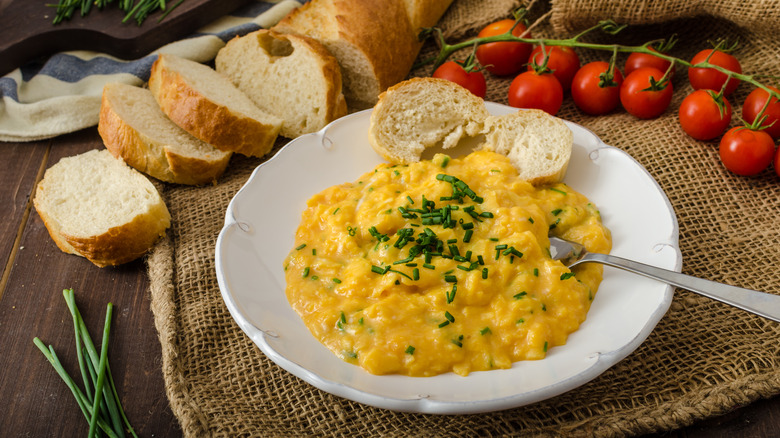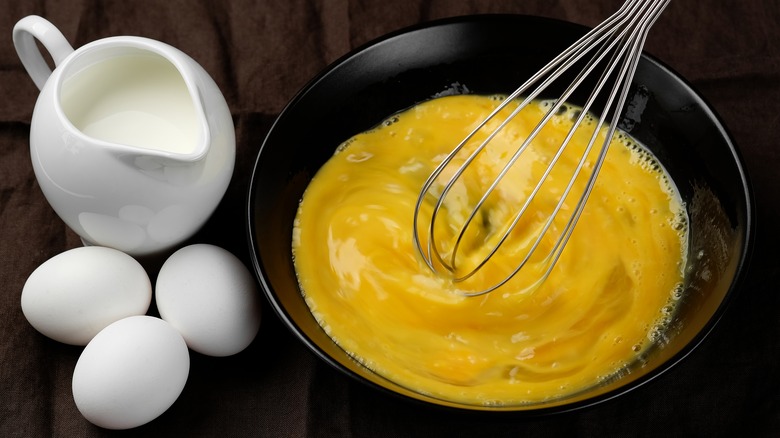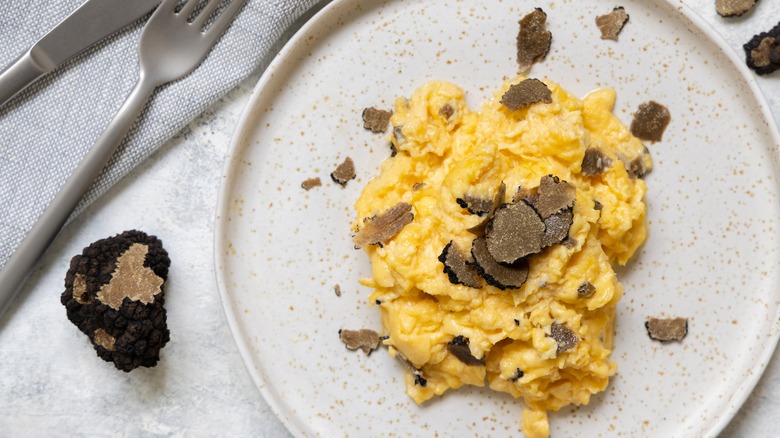You'll Want French Scrambled Eggs Every Day After One Bite
We may receive a commission on purchases made from links.
Scrambled eggs are one of those breakfast or brunch dishes that's immediately comforting but also feels a little bit special. There are so many variations in style, flavor, and texture when it comes to how the world eats scrambled eggs, whether to start the day or for lunch or dinner.
In France, as you might expect from a country with such an illustrious culinary history, scrambled eggs are a luxuriously silky and sophisticated affair. French scrambled eggs, also known as œufs brouillés, are quite different from the typical American style. Rather than being fluffy with large curds, French scrambled eggs have a uniquely soft texture, with much smaller curds, and an almost pourable texture. And they're also incredibly rich, creamy, and buttery-tasting, too.
The key to the differences is due to the cooking method, with French scrambled eggs usually taking a low-and-slow approach so that they gently reach their optimum creamy, custard-like consistency, as opposed to quickly-cooked American eggs. But the exact route to get to that desirable end result varies, as do the precise ingredients required, with many chefs practicing and perfecting their own individual style of preparation.
There are several methods to make the best œufs brouillés
To get creamy, barely-set French-style scrambled eggs, use a whisk to mix the eggs before they're cooked (one of the genius tricks to enjoy scrambled eggs like never before) as well as when they're slowly cooking. Some chefs even blend the eggs before they hit the pan so they're especially smooth. The continuous whisking breaks down the curds so that they remain small and also reduces fluffiness by knocking out the air from any bubbles within the eggs as they get warmer.
The eggs can either be cooked in a saucepan over low heat, or some chefs choose to use a double boiler or bain-marie, whisking the eggs in a bowl set over a pan of simmering water. Both methods take time, around five to 10 minutes and even up to 15, so they remain custardy and pourable. Taking the eggs off the heat just before they reach the desired consistency is key, too, since they carry on cooking in the residual heat in the pan.
As well as their soft and silky texture from the low temperature, French scrambled eggs are also usually further enriched with the addition of dairy, such as butter or heavy cream, toward the end of the cooking process, which also stops them from continuing to cook, and helps the consistency stay looser. Whole milk or crème fraîche could also be used for a slightly lighter result.
Variations on French scrambled eggs for a luxurious brunch
French scrambled eggs are perfect served poured over buttered toast — such as brioche or slices of toasted baguette as a breakfast or brunch dish — since their liquidy texture and rich buttery taste means you probably don't want a large plateful served on their own. They can be further elevated with additions such as fresh chopped herbs, bacon, or smoked salmon. But there are other variations on the French-style eggs you could try, too.
According to the classic French cookery book "Larousse Gastronomique," for scrambled eggs Massenet, the eggs are mixed with asparagus tips and diced artichoke hearts that have been sauteed in butter. Or even fancier scrambled eggs, à l'arlésienne, sees the soft scrambled eggs mixed with sauteed diced zucchini flesh and tomato fondue, which is used to fill the cooked zucchini shell before it's topped with Parmesan and browned in a gratin dish.
Or, for the ultimate in decadence, add truffles. In brouillade aux truffes de Touraine, the soft scrambled eggs are adorned simply with shaved fresh truffles. But for a less expensive but still classy and aromatic alternative, try using truffle butter to give the eggs a luxury lift and a little je ne sais quoi.



